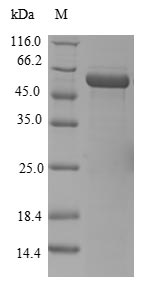Recombinant Human ELAV-like protein 4 (ELAVL4) gets expressed in E.coli and covers the complete length of isoform 1, running from amino acids 1-380. The protein carries an N-terminal 10xHis-SUMO tag plus a C-terminal Myc tag, which appears to make purification and detection more straightforward. SDS-PAGE analysis shows the protein achieves greater than 90% purity, suggesting it should work well for different research applications.
ELAV-like protein 4, or ELAVL4, seems to play an important role in post-transcriptional regulation through RNA binding. The protein is likely involved in controlling mRNA stability and translation - processes that may be essential for understanding how cells handle RNA processing and gene expression. Given its RNA binding and regulatory functions, ELAVL4 has become a key target for studying cellular responses, particularly in neurological research.
Potential Applications
Note: The applications listed below are based on what we know about this protein's biological functions, published research, and experience from experts in the field. However, we haven't fully tested all of these applications ourselves yet. We'd recommend running some preliminary tests first to make sure they work for your specific research goals.
Based on the provided information, the recombinant Human ELAVL4 is expressed in E. coli, a prokaryotic system that is generally unsuitable for producing functional eukaryotic RNA-binding proteins like ELAVL4. ELAVL4 requires precise folding of its RNA recognition motifs (RRMs) for proper RNA binding activity, and may need post-translational modifications that E. coli cannot provide. The protein is full-length (1-380aa) with dual tags (N-terminal 10xHis-SUMO and C-terminal Myc), which together add significant molecular weight that could interfere with proper folding or domain accessibility. While the SUMO tag may improve solubility, the complex tag arrangement increases the risk of misfolding. Since activity is unverified, the protein cannot be assumed to be correctly folded or bioactive without functional validation (e.g., RNA binding assays).
1. Protein-Protein Interaction Studies Using Pull-Down Assays
The dual tagging system technically enables pull-down approaches, but if ELAVL4 is misfolded, it may not interact physiologically with true binding partners (e.g., other RNA-binding proteins or specific mRNAs). The tags facilitate immobilization but may cause steric hindrance or non-specific interactions. This application should only be pursued after confirming proper folding through functional RNA binding assays. If misfolded, identified interactions may be artifactual.
2. Antibody Development and Validation
This application is appropriate. The recombinant ELAVL4 can serve as an effective immunogen for generating antibodies, as antibodies may recognize linear epitopes even if the protein is misfolded. The full-length sequence ensures coverage of multiple antigenic regions. However, if misfolded, antibodies may not recognize conformational epitopes of native ELAVL4 in cellular contexts. Validation against endogenous ELAVL4 is recommended.
3. Biochemical Characterization and Stability Studies
This application is well-suited and should be prioritized. Techniques like size exclusion chromatography, dynamic light scattering, and thermal stability assays can directly assess the protein's folding state, oligomerization, and aggregation propensity. These studies are valuable even if the protein is inactive. The dual tags aid in purification and quantification.
4. Tag-Based Protein Localization and Trafficking Studies
This application is highly problematic. Introducing recombinant ELAVL4 into cells for localization studies assumes proper folding and functionality, which is unverified. Misfolded protein may mislocalize or aggregate, leading to incorrect conclusions about native trafficking. The tags themselves may alter localization patterns. This application should be avoided unless proper folding and RNA-binding functionality are confirmed.
Final Recommendation & Action Plan
Given the high probability of misfolding in E. coli for this complex eukaryotic RNA-binding protein, it is essential to first validate the protein's conformation and function. Recommend performing: 1) Biophysical analysis (size exclusion chromatography, circular dichroism) to assess folding state; 2) Functional RNA binding assays using known ELAVL4 RNA targets to confirm bioactivity. If validated, the protein can be used for interaction studies; if not, focus on antibody development and biochemical characterization. Avoid cellular localization studies entirely with this recombinant protein. For reliable functional studies, consider alternative expression systems (e.g., mammalian cells) that can produce properly modified and folded ELAVL4. Always include






